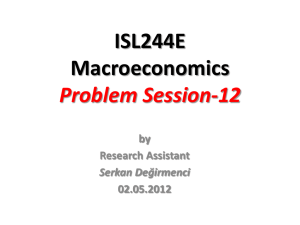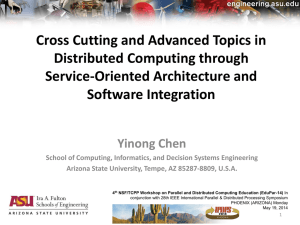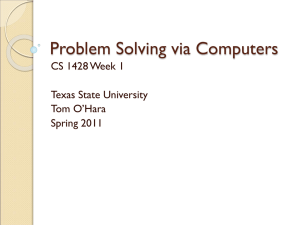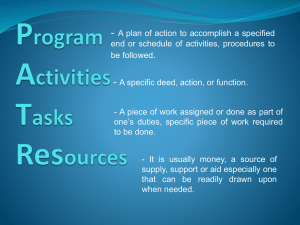Architecture-based Reliability Analysis of Web Services in - S-Cube
advertisement
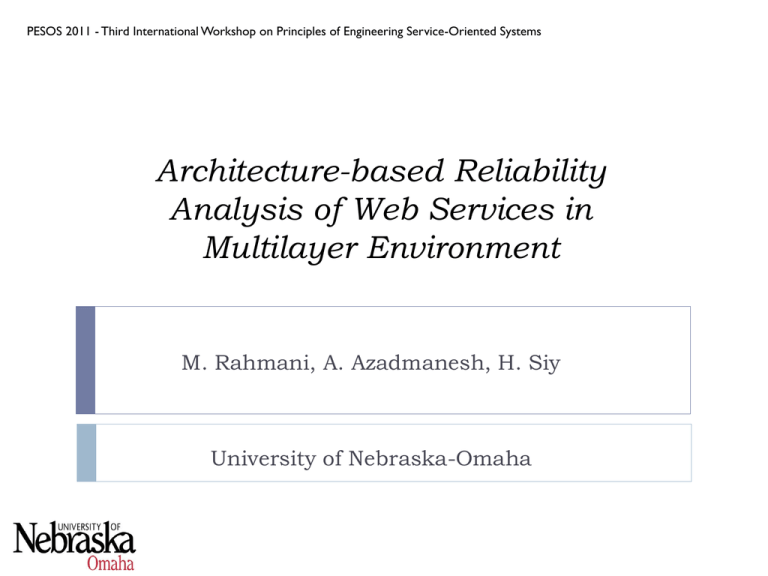
PESOS 2011 - Third International Workshop on Principles of Engineering Service-Oriented Systems
Architecture-based Reliability
Analysis of Web Services in
Multilayer Environment
M. Rahmani, A. Azadmanesh, H. Siy
University of Nebraska-Omaha
PESOS 2011 - Third International Workshop on Principles of Engineering Service-Oriented Systems
Agenda
Introduction
Objectives
Background (Petri-net, SRN)
Our modeling approach
Experimental analysis
Preliminary results
Conclusion
2
PESOS 2011 - Third International Workshop on Principles of Engineering Service-Oriented Systems
Introduction
Architecture-based reliability analysis
Individual reliability of components
Architecture of software based on components
Web service reliability analysis
Due to the hierarchical complexity of layers, architecture-based
reliability analysis of system is challenging
E.g. one of the major causes of failure in web services is resource
exhaustion
3
PESOS 2011 - Third International Workshop on Principles of Engineering Service-Oriented Systems
Objectives
Reliability analysis of web services where some details of
underlying layers and configuration settings are taken into
account. (Main layers: Web server, Application server, Web service, and
database)
Stochastic Petri Net (SPN) is used as an state-based
modeling in reliability modeling
4
PESOS 2011 - Third International Workshop on Principles of Engineering Service-Oriented Systems
Objectives - Rationale
One of the main causes of failures in web applications is not
logical or computational error, but rather system overload,
configuration errors, and resource exhaustion [Per05] .
Many of component-based reliability approaches to servicebased environment do not consider these types of failures
[Gra05] [ Zho06] .
Although some authors claim that component-based reliability
approaches can be applied to service-oriented computing
applications, to the best of our knowledge, no solid work
exists to prove this [Gra06] .
5
PESOS 2011 - Third International Workshop on Principles of Engineering Service-Oriented Systems
Objectives - Rationale
In this study, the layers are modeled as “gray boxes” or
“gray layers”, where a layer constitutes an autonomous
logical behavior, and yet some details of code behavior and
configuration settings are taken into account.
6
PESOS 2011 - Third International Workshop on Principles of Engineering Service-Oriented Systems
Background
Petri net modeling
A Petri net graph consists of a set of places P, a set of transitions T, and a set
of arcs F.
A marked Petri net (also called Petri net) is a 4-tuple (P, T, F, M0), where (P, T,
F) is a Petri net graph and M0 is the initial marking of Petri net graph.
A Petri net example
7
PESOS 2011 - Third International Workshop on Principles of Engineering Service-Oriented Systems
Background
SRNs (Stochastic Reward Nets) [Zho06] are considered in
this research.
A GSPN is a 6-tuple (P, T, F, W, M0, λ).
P = {p1, p2... pk} is a finite set of places.
T is a finite set of transitions partitioned into two subsets: TI (immediate) and TD (timed)
transitions, where transition t ∈ TD are associated with rate λ.
F ⊆ (P ∗ T) ∪ (T ∗ P) is a set of arcs.
M0 = {m01, m02… m0k} is an initial marking.
W: T → R is a function, which is defined on the set of transitions, where R is the set of
non-negative real numbers. TD is associated with priority zero, whereas all other priority
levels are reserved for immediate transitions.
SRNs are an extension of GSPNs
SRNs include all the features of GSPNs and many more such as guards, timed transition
priorities, halting conditions, and reward rates [Tri93].
8
PESOS 2011 - Third International Workshop on Principles of Engineering Service-Oriented Systems
The modeling approach
The proposed approach of architecture-based software reliability
9
PESOS 2011 - Third International Workshop on Principles of Engineering Service-Oriented Systems
Dynamic Analysis
Instrument application server with a profiler
AppDynamics [ App] or JRAT [JRA]
Execute web service test cases
Web server
Web service
Application server
10
PESOS 2011 - Third International Workshop on Principles of Engineering Service-Oriented Systems
Static Analysis
Extract main layers
using some architectural tools such as
Structure 101
Extract configuration parameters (mostly gathered from
performance analysis literature)
Http thread pool in the web container,
(server.xml)
EJB instance pool in EJB container,
(standardjboss.xml)
Database connection pool of the data access
layer
(hsqldb-ds.xml)
11
PESOS 2011 - Third International Workshop on Principles of Engineering Service-Oriented Systems
Form Architecture Model
Considering the major layers and resources
extracted from the previous step, an
architecture model will be built .
Architecture of JBoss, showing the interaction between layers and shared
resources
12
PESOS 2011 - Third International Workshop on Principles of Engineering Service-Oriented Systems
Parameter Estimation
(the purpose of this phase is to attain the
information needed to build the
stochastic behavior among and within the
layers)
Estimate transition probabilities between
layers
Estimate time spent in each layer
Gather failure probability in each layer
13
PESOS 2011 - Third International Workshop on Principles of Engineering Service-Oriented Systems
Estimate time spent in each layer
compute time spent in each layer in JRAT output
Web server
Web service
Application server
14
PESOS 2011 - Third International Workshop on Principles of Engineering Service-Oriented Systems
Gather failure probability in each layer
Gather failures from server.log or from other web service packages such
as SOAPUI and JMeter.
Map each failure to the layer in which the failure has occurred
15
PESOS 2011 - Third International Workshop on Principles of Engineering Service-Oriented Systems
SRN (Stochastic Reward Net)
Timed activities, Transition rates, failure
probability of each layer, and configuration
parameters are determined
Start
Web
container
Start Application
Server
Rest of model
Http Thread
pool
Fail
16
PESOS 2011 - Third International Workshop on Principles of Engineering Service-Oriented Systems
Modeling tool: Mobius [Mob]
Reasons for adopting Mobius:
Mobius is built with SRN in mind, so asynchronous behavior
can be described concisely.
Provides graphical user interface.
Provides various distribution models (exponential,etc.)
Provides a hierarchical modeling, similar to software
modularization.
17
PESOS 2011 - Third International Workshop on Principles of Engineering Service-Oriented Systems
Gather and Analyze Results
The final phase of this approach is to run
the Petri net model, collect, and analyze
the results .
18
PESOS 2011 - Third International Workshop on Principles of Engineering Service-Oriented Systems
Experimental analysis
The Case Study
Duke’s Bank Web service
Running on JBoss AS 4.2.2 (Default Web server: Apache Tomcat 6.0.13)
Windows Vista (Intel 2.66GHz, Memory 2G)
WS
Client
Web service invocation
Web Container
(Tomcat )
Http11ConnectionHandler
SOAP
Http
EJB Container
Session container Entity container
Teller
Bean
Account
Controller
Bean
Partial view of Duke’s Bank Web Service
architecture
19
Account
Bean
Data Base
(Hsqldb)
PESOS 2011 - Third International Workshop on Principles of Engineering Service-Oriented Systems
Preliminary Results
The Petri net sub-model representing the communication between web server,
application server, and web service
20
PESOS 2011 - Third International Workshop on Principles of Engineering Service-Oriented Systems
Preliminary Results
Reliability based on maximum number of threads
in thread pool and maximum number of EJB in EJB
pool
21
Parameters set for Petri net model
PESOS 2011 - Third International Workshop on Principles of Engineering Service-Oriented Systems
Preliminary Results
Reliability through the time based on maximum number of threads in
thread pool
22
PESOS 2011 - Third International Workshop on Principles of Engineering Service-Oriented Systems
Conclusion
The service-based system is modeled using the layered
architecture style.
The system is mapped to a Petri net model in order to
estimate the overall reliability under various conditions
and scenarios.
Although failures originated from misconfiguration is one
of the common types of failures in web services, there is
not much attention to these failures in architecture based
software reliability approaches.
23
PESOS 2011 - Third International Workshop on Principles of Engineering Service-Oriented Systems
Conclusion
The main contribution of this research study is the
reliability modeling of the entire web service system and
the configuration parameters of the underlying
middleware.
By including the multilayer approach and inclusion of the
appropriate configuration parameters, it is expected that
a more accurate reliability prediction of web service
software is possible.
24
PESOS 2011 - Third International Workshop on Principles of Engineering Service-Oriented Systems
Thank you
&
Questions?
26
